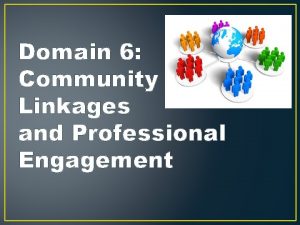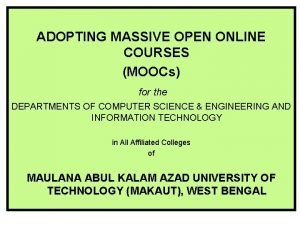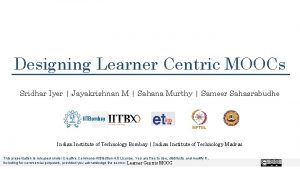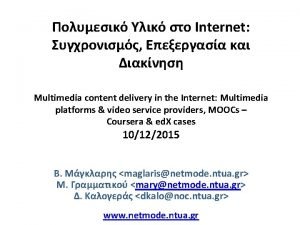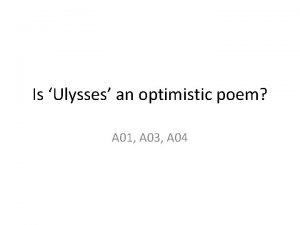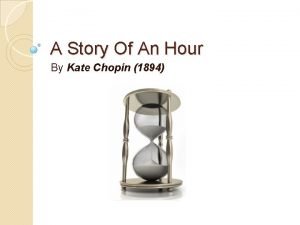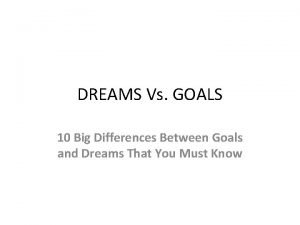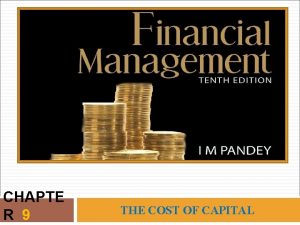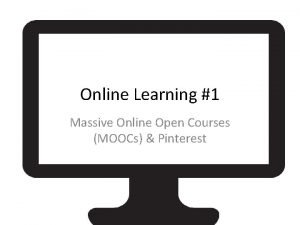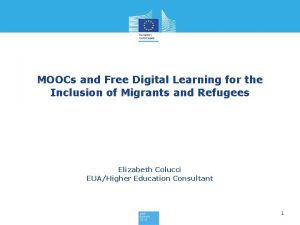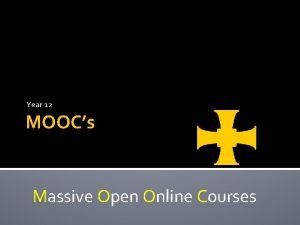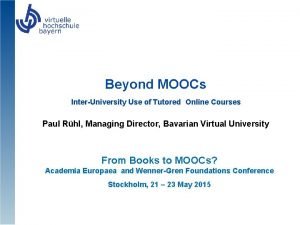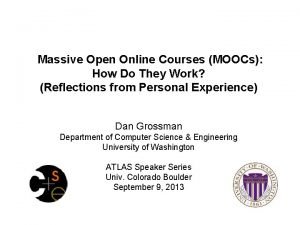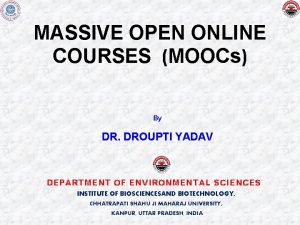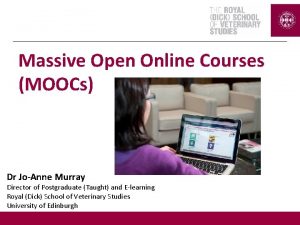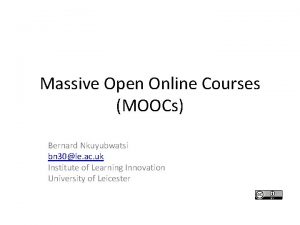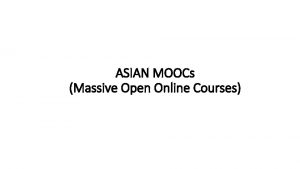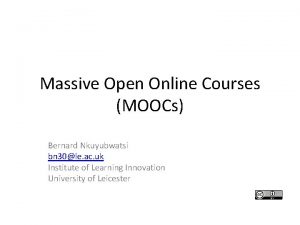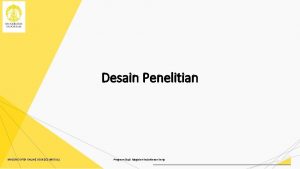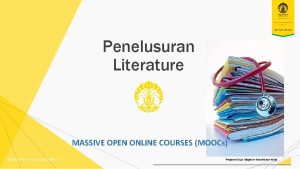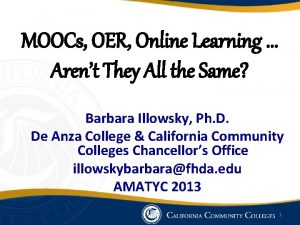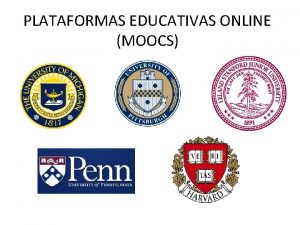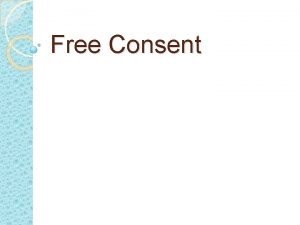The High Cost of Free Online Education MOOCs



























- Slides: 27

The High Cost of “Free” Online Education: MOOCs Revisited, With Some Policy Suggestions May 23, 2015 “Emerging Models of Learning & Teaching in Higher Education: From Books to MOOCs? ” The Academea Europea & Wenner-Grens Foundation Conference Stockholm, Sweden Michael A. Cusumano MIT Sloan School of Management cusumano@mit. edu

Introductory • My background & interests not in education or digital learning, but rather in what today we call software & internet/digital “platform businesses” • • • 1995 Technology & competitive strategy Software development Platform strategy & dynamics Software & Internet Business models Also member of the Presidential Task Force on the Future of MIT Education (2013 -2014), subcommittee & coordinating committee 1998 2002 2004 2010 2013 2015 2

Platforms? • Bring different people together for some common purpose, often with access to a shared resource • Whether it is to catch the same train, use common software applications, or learn from the same MOOC • Internet & software platforms can generate powerful “network effects” & exponential growth – Do we want MIT, Harvard & Stanford to become like Intel, Microsoft, Apple, Google & Amazon in the world of MOOCs? – And other universities to struggle, like so many newspapers, magazines, music & book publishers, software firms, et al. ? 3

Tragedy of the Commons? • M. A. Cusumano, “Are the Costs of ‘Free’ Too High in Online Education? ” Communications of the ACM, April 2013 • M. A. Cusumano, “MOOCs Revisited, With Some Policy Suggestions, ” Communications of the ACM, April 2014 *p. 24 “Probably the most disturbing response to my [2013] column came from a professor in the U. S. who had decided to teach his course on one of the major MOOC platforms. He thought MOOCs would be the future and did not want to be left behind. Yet, he confessed regret that he might be contributing to the ‘tragedy of the commons’: He feared his individual decision would not be good in the long run for his university or for the education profession. The image that came immediately to my mind was of the natives on Easter Island who cut down the last tree. They got fuel for another day but eventually their civilization collapsed. Did they know what they were doing? ”* 4

That is the question I began asking in 2012 at MIT: Do we know what we are doing? 5

General Assumptions I • MOOC content & software (online slides, video lectures, robot graders) constitute a new form of digital good • Marginal cost of reproduction = zero (or close). But other digital goods have not really been “free” – Digital platforms always subsidize one “market side” (e. g. , users of free content) by charging another side (e. g. , advertisers) • Free MOOCs = high cost to design, produce, maintain – Fixed costs can be very high (e. g. , salaries & labs of professors, capital investment, other university overhead) though leveraged over multiple users/projects – Variable costs can be high (designers, production systems, TAs) – Someone has to pay & that is where “democracy” breaks down 6

General Assumptions 2 • Multi-sided platform markets often “tip” toward one or a small number of “winners, ” when there are: – Strong network effects (increasing returns or positive feedback loops), – Little differentiation across competing platforms (market tends not to fragment or create niches), and – High costs for “multi-homing” – i. e. , costly for users or other participants (e. g. app or content creators) to use more than one platform as their “home” References: Eisenmann, Parker, and van Alstyne, “Strategies for Two-Sided Markets, ” Harvard Business Review (2006); Cusumano, “The Evolution of Platform Thinking, ” Communications of the ACM , Jan. 2010; Staying Power (2010) and others 7

Initial Hypotheses (April 2013) • MOOC platforms generate (1) strong network effects with (2) little platform differentiation (though it may increase in future, e. g. by language & geography). No specific obstacles to (3) multihoming (e. g. , from loyalty/degree programs). Nonetheless, a small number of MOOC platforms likely to become dominant, though several could emerge. • Similar to software, music, newspapers, books, video clips, encyclopedias – many users expect MOOCs as digital goods to be “free, ” at marginal (reproduction) cost • Actual full costs must therefore be subsidized by wealthy institutions (universities, foundations, venture capital) or 8 funded indirectly (e. g. platforms selling ads, CVs)

Students Content Providers MIT, Harvard, Stanford, Penn, et al MOOC Platform (Ed. X, Coursera) Advertisers? Foundation/Corporate Partners? Apps? 9

Negative Industry Implications I • Long-term pressure from changing demographics & economics already hurting tuition-dependent colleges – Elite private institutions stable, but CFOs worried – Government-supported institutions are different but may also face increasing budget pressures and demographic pressures • “Free” online education may harm financially weak but still useful regional & local institutions – Dramatic consolidation in other digital-affected industries, somewhat offset by user-generated content – Not clear we are better off with fewer professional newspapers, book & magazine publishers, software product firms, etc. • Even the NY Times nearly went bankrupt twice after starting with ”free” content. It needs 7 x historical peak monthly page views to support operations via ads. Better after instituting a paywall & digital subscription fees 10

Negative Industry Implications 2 • Consolidation/failure of tuition-dependent colleges & universities may result in fewer choices for students, not more, and more dominance by a few elite institutions – In areas without government support, education may become even more centralized & elitist, and less localized & responsive -- the oppose of what MOOCs originally promised • Fewer choices & more reliance on a few MOOC platforms especially problematic because of MOOC limitations – – – MOOCs today do not address needs of many/most students; e. g. , most MOOCs users in mid-30 s & already highly educated Only a small fraction of registrants complete MOOCs courses; complex reasons but something seems wrong in delivery? Most students do better with “blended” learning, a more expensive & less scalable education model than simple MOOCs 11

Positive Industry Implications • MOOCs can enable learning & education at scale, with exponential growth, similar to other digital/internet – Cost of education large & growing with world population – Huge student debt in US becoming a social & economic problem • We don’t need low quality institutions anyway – Weak/small private universities/colleges declining – Dubious “for-profit” colleges & universities starting to fail – good!! • High quality institutions not (yet) threatened – Wealthy universities & colleges already provide a lot of financial aid – Their “net tuition” relatively low (though still high compared to “free”) – Financial burden mostly from good but lower tier private institutions that charge high tuition without much financial aid 12

Example: MIT’s Financial Model (similar economics at top-tier U. S. private research universities – but not similar at private teaching-focused institutions) 13

14

15

16

Minus Lincoln Labs Financial losses. MIT would not have subsidized MOOCs ca. 2001 -2008 17

MOOCs Revisited 1 (April 2014) • A few dominant MOOCs platforms have emerged! 1. Ed. X, non-profit led by MIT & Harvard; Coursera, for-profit led by Stanford. Not clear- Udacity, for profit (partnering with companies). Others emerging in Europe, China, etc. 2. Financial impact of MOOCs unclear. Wealthy private universities (MIT, Harvard, Stanford, Yale, etc. ) still in “surplus” – can subsidize MOOCs & aid their own students. Not so at many other private & some public institutions? 3. Consolidation or closing of weaker colleges and universities continues, but probably not driven by MOOCs “threat” 18

MOOCs Revisited 2 (April 2014) • MOOC platforms are responding to charges of “elitism” &“unsustainable business models” 1. Platform “Openness”: Ed. X in May 2015 had 60 institutions contributing content and Coursera 119 institutions. 2. Business Models: “Free, but not Free” – Now charging nominal fees, such as for certificates. Licensing some content for a fee, such as to community colleges. 3. Complements, Not Substitutes: MOOCs not likely to replace traditional universities & colleges, but complement 19

Policy Questions & Suggestions 1. Should MOOCs aimed at “general education” remain “free”? – Yes, as long as wealthier institutions, governments (taxes), foundations (philanthropy) or even venture capitalists (their goals? ) are willing to provide subsidies. Or if some indirect funding model can pay the costs (e. g. , selling certificates, ads, student resumes like Linked. In, books) 20

Policy Questions & Suggestions 2. Should MOOCs with a credential, grade, or credit toward a degree be “free”? -- Maybe, where university education is near-free already & those institutions offer some classes as MOOCs (e. g. , in Europe). -- No, if we want to avoid encouraing a threshold price or expectation for education priced at “zero. ” • Note: Even a nominal charge might actually improve completion rates of MOOCs 21

Policy Questions & Suggestions 3. What about free MOOCs as a form of educational & economic philanthropy? -- Yes, some MOOCs can/should still be free if their platform sponsors offer scholarships or tuition breaks to needy students, e. g. in developing countries or low-income families. 22

Policy Questions & Suggestions 4. How should universities treat MOOCs in terms of degree credit & tuition? -- Treat internal MOOCs as regular classes, with grades and tuition (maybe discounted) -- Treat external MOOCs as transfer credits from another institution (e. g. , maybe some limits on amount of transfer credit, grades, need for home matching courses, sometimes not allowed, etc. ) 23

Policy Questions & Suggestions 5. Should students be able to get a college degree simply by taking MOOCs? -- Qualified Yes. We already have online degree programs & a history of “correspondence courses. ” A MOOCs degree, however, should be specially designated, like an extension school degree. -- Ed. X, Coursera, et al. may also evolve into “online degree-granting institutions, ” with degrees distinguished from their founding institutions 24

Other Complications • “Free riding” on free/near free MOOCs by feecharging or “for profit” degree-granting institutions • Open vs. selective admissions -- impact on student quality, or quality/meaning of “grades” & credit • Future value of traditional college/university degrees vs. other forms of qualifications – Some of my MIT colleagues would be quite happy to eliminate universities & degrees as we know them and let employers figure out how to select employees 25

Conclusions I • MOOCs = Tragedy of the Commons? Not yet. – MOOCs not replacing undergraduate or graduate education – MOOCs more a “complement” than substitute for residential education – Business models are emerging … – MOOCs can help reduce educational costs, e. g. by years in school – Big role in continuing education/extension school-type of learning – MOOCs a great source of data for education R&D – MOOCs could become a new source of education funding – But how address more systematically the costs & benefits as well as the policy implications? 26

Conclusions 2 • What is “Job 1” for faculty – Research? Teach our own students? Teach the world? – MOOCs can be very time-consuming to design & deliver well – Detract from teaching local students … or help both? ? – Becoming a “MOOCs rock-star” seems a distraction, though perhaps not so different from writing mass-market books or TV documentaries – Pressure for faculty at major research universities to create MOOCs may detract from basic research needed to create new learning? – Biggest “tragedy of the commons” will be if we fail to leverage the potential benefits of MOOCs as a new Internet/digital platform 27
 Community linkages and professional engagement of teachers
Community linkages and professional engagement of teachers Moocs makaut
Moocs makaut Designing learner-centric moocs
Designing learner-centric moocs Designing learner-centric moocs
Designing learner-centric moocs Internetmultimedia org live stream
Internetmultimedia org live stream Uci parking zones
Uci parking zones Gibbs free energy of formation
Gibbs free energy of formation Negative free energy change
Negative free energy change What is delta g
What is delta g Kernel dynamic memory
Kernel dynamic memory Helmholtz free energy
Helmholtz free energy Free hearts free foreheads
Free hearts free foreheads Plot story of an hour
Plot story of an hour Free-free absorption
Free-free absorption Goals vs dreams
Goals vs dreams Cost accumulation and cost assignment
Cost accumulation and cost assignment Cost accumulation and cost assignment
Cost accumulation and cost assignment Manufacturing cost vs non manufacturing cost
Manufacturing cost vs non manufacturing cost Job costing with process costing
Job costing with process costing Whats financial leverage
Whats financial leverage Commited cost
Commited cost Cost pools
Cost pools Manufacturing cost vs non manufacturing cost
Manufacturing cost vs non manufacturing cost Material price variance
Material price variance Flotation cost in cost of equity
Flotation cost in cost of equity What is a period cost on the income statement
What is a period cost on the income statement Dennis geyer
Dennis geyer Define standard costing
Define standard costing
